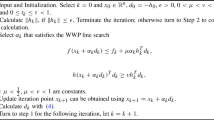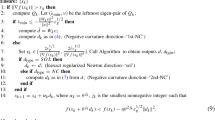Summary
We examine a class of approximate inversion processes, satisfying estimates similar to those defined by finite element or truncated spectral approximations; these are to be used as approximate right inverses for Newton iteration methods. When viewed at the operator level, these approximations introduce a defect, or “loss of derivatives”, of order one or more. Regularization is introduced as a form of defect correction. A superlinearly convergent, approximate Newton iteration is thereby obtained by using the numerical inversion adaptively, i.e., with spectral or grid parameters correlated to the magnitude of the current residual in an intermediate norm defined by the defect. This adaptive choice makes possible ascribing an order to the convergent process, and this is identified as essentially optimal for elliptic problems, relative to complexity. The design of the algorithm involves multi-parameter selection, thereby opening up interesting avenues for elliptic problems, relative to complexity. This applies also to the regularization which may be carried out in the Fourier transform space, and is band-limited in the language of Whittaker-Shannon sampling theory. The norms employed in the analysis are of Hölder space type; the iteration is an adaptation of Nash-Moser interation; and, the complexity studies use Vituškin's theory of information processing. Computational experience is described in the final section.
Similar content being viewed by others
References
Bank, R., Rose, D.: Global approximate Newton methods. Numer. Math.37, 279–295 (1981)
de Boor, C.: On local linear functionals which vanish at allB-spines but one. In: Theory of Approximation, with Applications (A.G. Law, B.N. Sahny, eds.), pp. 120–145. New York: Academic Press 1976
Butzer, P.: A survey of the Whittaker-Shannon sampling theorem, and some of its extensions. J. Math. Res. Expo.3, 195–212 (1983)
Descloux, J.: On finite element matrices. SIAM J. Numer. Anal.9, 260–265 (1972)
Douglas, J., Dupont, T., Wahlbin, L.: OptimalL ∞ error estimates for Galerkin approximations to solutions of two-point boundary value problems. Math. Comput.29, 475–483 (1975)
Grosse, E.: Ph.D. Dissertation. Department of Computer Science, Stanford University, Stanford, California (1980)
Hormander, L.: The boundary problems of physical geodesy. Arch. Ration. Mech. Anal.62, 1–52 (1976)
Jerome, J.: Approximate Newton methods and homotopy for stationary operator equations. Constructive Approximation (To appear, 1985)
Jerome, J.: Approximation of Nonlinear Evolution Systems. New York: Academic Press 1983
Lorentz, G.: Metric entropy and approximation. Bull. Am. Math. Soc.72, 903–937 (1966)
Moser, J.: A rapidly convergent iteration method and nonlinear partial differential equations I. Ann. Scuola Norm. PisaXX, 265–315 (1966)
Nirenberg, L.: Topics in Nonlinear Functional Analysis. Courant Institute of Mathematical Sciences, New York University, New York (1973–74)
Nitsche, J.:L ∞ convergence of finite element approximation. Rennes Conf. Finite Elements, 2nd. Rennes, France: University 1975
Schatz, A., Wahlbin, L.: On the quasi-optimality inL ∞ of theH 1 projection into finite element spaces. Math. Comput.38, 1–22 (1982)
Triebel, H.: Fourier Analysis and Function Spaces. Leipzig: Teubner 1977
Vituškin, A.: Theory of Transmission and Processing of Information. New York: Pergamon 1961
Author information
Authors and Affiliations
Additional information
Research supported by National Science Foundation grant MCS-8218041. This is the second part of work in progress during the author's visit to the Institute for Mathematics and its Applications, University of Minnesota, Minneapolis, USA
Rights and permissions
About this article
Cite this article
Jerome, J.W. An adaptive Newton algorithm based on numerical inversion: Regularization as postconditioner. Numer. Math. 47, 123–138 (1985). https://doi.org/10.1007/BF01389880
Received:
Issue Date:
DOI: https://doi.org/10.1007/BF01389880




